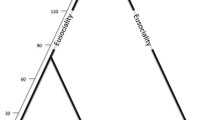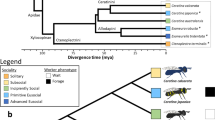Abstract
Comparative analyses of genomes of ten bee species representing different degrees of social complexity have demonstrated that independent transitions to eusociality are often accompanied by or lead to expansions or contractions of gene families (albeit different families across independent lineages). Because collective gathering, processing, and storage of plant products is a hallmark of bee social complexity, we examined the genomic inventory of cytochrome P450 genes (the CYPome) in these ten genomes, to search for footprints of eusociality in phytochemical detoxification pathways and, using a Bayesian implementation of the McDonald–Kreitman test, evidence of adaptive evolution within P450 lineages associated with food processing in eusocial florivorous Bombus and Apis species versus eusocial carnivorous Polistes species.We found no patterns linking CYPome size to level of social complexity within the ten bee genomes at the gene family level; however, a pattern emerged at the subfamily level, with the CYP6AS subfamily most diverse in perennial eusocial resin-collecting bees. In Apis mellifera, several CYP6AS enzymes are known to metabolize flavonols, ubiquitous constituents of nectar and honey, pollen and beebread, and resins and propolis. CYP6AS subfamily size varies from 7 in the solitary Habropoda laboriosa and the facultatively eusocial Lasioglossum albipes to 17 in the perennial eusocial Melipona quadrifasciatus; the degree of sociality across the ten species is correlated with CYP6AS inventory size (Spearman’s rho = 0.704, p < 0.023). Remarkably, there is perfect overlap between CYP6AS genes upregulated by the flavonol quercetin in A. mellifera and CYP6AS genes with signs of adaptive evolution in either Apis or Bombus. Our finding of positive selection on CYP6AS genes in Apis and Bombus, but not Polistes supports the hypothesis that CYP6AS subfamily expansion was involved in facilitating the shift from carnivory to florivory in bees. That some CYP6AS enzymes metabolize flavonoids suggests that subfamily expansion results from increased evolutionary exposure to these phytochemicals, through concentration of nectar into honey, pollen into beebread, and plant resins into propolis. Accompanying the evolutionary progression from solitary to perennial eusocial behavior in bees is a transition from short-term storage of ephemeral low-quality resources to concentrating and stockpiling those resources for colony use, with a concomitant need for phytochemical detoxification.


Similar content being viewed by others
Abbreviations
- P450:
-
Cytochrome P450
References
Adler LS (2000) The ecological significance of toxic nectar. Oikos 91:409–420
Altschul SF, Madden TL, Schäffer AA, Zhang J, Zhang Z, Miller W, Lipman DJ (1997) Gapped BLAST and PSI-BLAST: a new generation of protein database search programs. Nucleic Acids Res 25:3389–3401
Bankova V, Popova M, Bogdanov S, Sabatini A-G (2002) Chemical composition of European propolis: expected and unexpected results. Zeitschr Naturforsch 57c:530–533
Bankova VS, Popova SS, Marekov NL (1983) A study on flavonoids of propolis. J Nat Prod 46:471–474
Berenbaum MR (2002) Post-genomic chemical ecology: from genetic code to ecological interactions. J Chem Ecol 28:873–896
Berenbaum MR (2016) Does the honey bee “risk cup” runneth over? Estimating aggregate exposures for assessing pesticide risks to honey bees in agroecosystems. J Ag Food Chem 64:13–20
Berenbaum MR, Johnson RM (2015) Xenobiotic detoxification pathways in honey bees. Curr Opin Insect Sci 10:51–58
Calla B, Noble K, Johnson RM, Walden KKO, Schuler MA, Robertson HM, Berenbaum MR (2017) Cytochrome diversification and hostplant utilization patterns in specialist and generalist moths: birth, death, and adaptation. Mol Ecol 26:6021–6035
Christe P, Oppliger A, Bancala F, Castella G, Chapuisat M (2003) Evidence for collective medication in ants. Ecol Lett 6:19–22
Claudianos C, Lim J, Young M, Yan S, Cristino AS, Newcomb RD, Gunasekaran N, Reinhard J (2014) Odor memories regulate olfactory receptor expression in the sensory periphery. Eur J Neurosci 39:1642–1654
Claudianos C, Ranson H, Johnson RM, Biswas S, Schuler MA, Berenbaum MR, Feyereisen R, Oakeshott JG (2006) A deficit of detoxification enzymes: pesticide sensitivity and environmental response in the honey bee. Insect Mol Biol 15:615–636
Cremer S, Armitage SA, Schmid-Hempel P (2007) Social immunity. Curr Biol 17:R693–R702
Debevec AH, Cardinal S, Danforth BN (2012) Identifying the sister group to the bees: a molecular phylogeny of Aculeata with an emphasis on the superfamily Apoidea. Zoolog Scr 41:527–535
Dogantzis KA, Harpur BA, Rodrigues A, Beani L, Toth AL, Zayed A. Insects with similar social complexity show convergent patterns of adaptive molecular evolution. Nat Sci Rep. (In Revision, SREP-17-54008A)
Drescher N, Wallace HM, Katouli M, Massaro CF, Leonhardt SD (2014) Diversity matters: how bees benefit from different resin sources. Oecologia 176:943–953
Eilertson KE, Booth JG, Bustamante CD (2012) SnIPRE: selection inference using a Poisson random effects model. PLoS Comput Biol 8:e1002806
Feyereisen R (2011) Insect CYP genes and P450 enzymes. In: Gilbert LI (ed) Insect molecular biology and biochemistry. Elsevier, London, pp 236–295
Gess SK (1996) The pollen wasps: ecology and natural history of the masarinae. Harvard University Press, Cambridge
Ghoul M, Andersen SB, West SA (2017) Sociomics: using omic approaches to understand social evolution. Trends Genet 33:408–419
Harpur BA, Chernyshova A, Soltani A, Tsvetkov N, Mahjoorighasrodashti M, Xu Z, Zayed A (2014) No genetic tradeoffs between hygienic behaviour and individual innate immunity in the honey bee, Apis mellifera. PLoS One 9:e104214
Harpur BA, Dey A, Albert JA, Patel S, Hines HM, Hasselmann M, Packer L, Zayed A (2017) Contribution of queen and worker traits to adaptive evolution differs between bumble bees and honey bees. Genome Biol Evol 9:2395–2402
Harpur BA, Kent CF, Molodtsova D, Lebon JMD, Alqarni AS, Owayss AA, Zayed A (2014) Population genomics of the honey bee reveals strong signatures of positive selection on worker traits. Proc Natl Acad Sci USA 111:2614–2619
Harpur BA, Zayed A (2013) Accelerated evolution of innate immunity proteins in social insects: adaptive evolution or relaxed constraint? Mol Biol Evol 30:1665–1674
Hermann K (1976) Flavonols and flavones in food plants: a review. Int J Food Sci Technol 11:433–448
Honeybee Genome Sequencing Consortium (2006) Insights into social insects from the genome of the honeybee Apis mellifera. Nature 443: 931–949
Johnson RM, Berenbaum MR. Johnson RM, Mao W, Pollock HS, Niu G, Schuler MA, Berenbaum MR (2012) Ecologically appropriate xenobiotics induce cytochrome P450s in Apis mellifera. PLoS One 7:e31051
Kapheim KM, Pan H, Li C, Salzberg SL, Puiu D, Magoc T, Robertson HM, Hudson ME, Venkat A, Fischman BJ, Hernandez A, Yandell M, Ence D, Holt C, Yocum GD, Kemp WP, Bosch J, Waterhouse RM, Zdobnov EM, Stolle E, Kraus FB, Helbing S, Moritz RFA, Glastad KM, Hunt BG, Goodisman MAD, Hause F, Grimmelikhuijzen CPJ, Pinheiro DB, Nunes FMF, Soares MPM, Tanaka ED, Simões ZLP, Hartfelder K, Evans JD, Barribea SM, Johnson RM, Massey JH, Southey BR, Hasselmann M, Hamacher D, Biewer M, Kent CF, Zayed A, Blatti C III, Sinha S, Johnston JS, Hanrahan SJ, Kocher SD, Wang J, Robinson GE, Zhang G (2015) Genomic signatures of evolutionary transitions from solitary to group living. Science 348:1139–1143
Karpe SD, Jain R, Brockmann A, Sowdhamini R (2016) Identification of complete repertoire of Apis florea odorant receptors reveals complex orthologous relationships with Apis mellifera. Genome Biol Evol 8:2879–2895
Katoh K, Standley DM (2013) MAFFT multiple sequence alignment software version 7: improvements in performance and usability. Mol Biol Evol 30:772–780
Liu FL, He JZ, Fu WJ (2005) Highly controlled nest homeostasis helps honey bees deactivate phenolics in nectar. Naturwissenschaften 92:297–299
MacIvor JS, Moore AE (2013) Bees collect polyurethane and polyethylene plastics as novel nest materials. Ecosphere 4:155
Mao W, Johnson RM, Rupasinghe S, Schuler MA, Berenbaum MR (2009) Quercetin-metabolizing CYP6AS enzymes of the pollinator Apis mellifera Hymenoptera: Apidae. Comp Biochem Physiol C: Toxicol Pharmacol 154:427–434
Mao W, Schuler MA, Berenbaum MR (2011) CYP9Q-mediated detoxification of acaricides in the honey bee (Apis mellifera). Proc Natl Acad Sci USA 31:12657–12662
Mao W, Schuler MA, Berenbaum MR (2013) Honey constituents upregulate detoxification and immunity genes in the western honey bee Apis mellifera. Proc Natl Acad Sci USA 10:8842–8846
Mao W, Schuler MA, Berenbaum MR (2015) A dietary phytochemical alters caste determination gene expression in honeybees. Sci Adv 1(7):e150079
Mao W, Schuler MA, Berenbaum MR (2017) Disruption of quercetin metabolism by fungicide affects energy production in honey bees (Apis mellifera). Proc Natl Acad Sci USA 114:2538–2543
Nasonia Genome Sequencing Consortium (2010) Functional and evolutionary insights from the genomes of three parasitoid Nasonia species. Science 327: 343–348
Oakeshott JG, Johnson RM, Berenbaum MR, Ranson H, Cristino AS, Claudianos C (2010) Metabolic enzymes associated with xenobiotic and chemosensory responses in Nasonia vitripennis. Insect Mol Biol 19:147–163
Prys-Jones OE, Corbet SA (2011) Bumblebees (naturalists’ handbooks), 3rd edn. Pelagic Publishing, Exeter
Rambaut A (2017) FigTree. http://tree.bio.ed.ac.uk/software/figtree/ Accessed 17 July 2017
Simone M, Evans JD, Spivak M (2009) Resin collection and social immunity in honey bees. Evolution 63:3016–3022
Stamatakis A (2014) RAxML version 8: a tool for phylogenetic analysis and postanalysis of large phylogenies. Bioinformatics 30:1312–1313
Starks PT, Blackie CA, Seeley TD (2000) Fever in honey bee colonies. Naturwissenschaften 87:229–231
Sugden EA, McAllen RL (1994) Observations on foraging, population and nest biology of the Mexican honey wasp, Brachygastra mellifica (Say) in Texas [Vespidae: Polybiinae]. J Kansas Entomol Soc 67:141–155
Wang DI, Moeller FE (1970) The division of labor and queen attendance behavior of Nosema-infected worker honey bees. J Econ Entomol 63:1539–1541
Wilson-Rich N, Spivak M, Fefferman NH, Starks PT (2009) Genetic, individual, and group facilitation of disease resistance in insect societies. Annu Rev Entomol 54:405–423
Zhang CP, Hu FL (2009) Flavonoids in propolis. Nat Prod Res Dev 21:1064–1090
Acknowledgements
We thank Amy Toth, Laura Beani, and André Rodrigues for providing access to the Polistes samples for sequencing. This work was supported by USDA AFRI072116 to MRB, the Natural Science and Engineering Research Council of Canada (AZ), and the National Institute of Food and Agriculture, US Department of Agriculture Hatch Project under OHO01277.
Availability of data and material
Manually annotated nucleotide and amino acid sequences for bee P450 genes are available in the supplemental information (Supplemental File S1). The raw data for the honey bee and bumble bee population genomics dataset are found on NCBI’s short read archive (accession SRP029219 and PRNJA347806, respectively). Accessions to the Polistes population genomic dataset will be available upon acceptance of Dogantzis et al. (in review).
Author information
Authors and Affiliations
Contributions
RMJ annotated all of the CYP genes in the ten bee genomes and in the wasp genomes; BH, KD, and AZ carried out the population genomic analysis of CYP6AS genes in Apis, Bombus, and Polistes, and MRB conceived of the project, devised the hypothesis, and provided the ecological context for the genomic work. All authors contributed to writing the manuscript.
Corresponding author
Ethics declarations
Conflict of interest
The authors declare that they have no competing interests.
Electronic supplementary material
Below is the link to the electronic supplementary material.
Rights and permissions
About this article
Cite this article
Johnson, R.M., Harpur, B.A., Dogantzis, K.A. et al. Genomic footprint of evolution of eusociality in bees: floral food use and CYPome “blooms”. Insect. Soc. 65, 445–454 (2018). https://doi.org/10.1007/s00040-018-0631-x
Received:
Revised:
Accepted:
Published:
Issue Date:
DOI: https://doi.org/10.1007/s00040-018-0631-x




